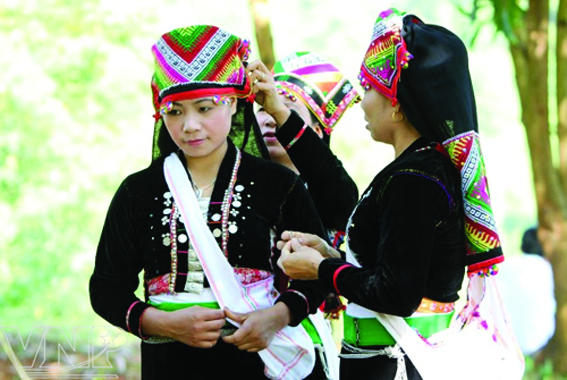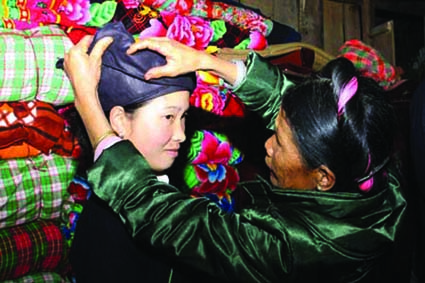>>Buffalo sacrifice ceremony in Xo Dang new year festival
Ta Thi Tam
Ethnology Institute
The Xo Dang, a Mon-Khmer language group, mainly lives in the Central Highlands province of Kon Tum with a population of nearly 170,000. The group, which is divided into local subgroups, namely Hdang (Xo Dang), Ca-dong, To-dra and Mo-nam, also settles in mountainous areas of the central provinces of Quang Ngai, Quang Nam and Binh Dinh.
The Xo Dang lives largely on swidden farming, using simple tools. Xo Dang people harvest rice by hand rather than with a sickle. Apart from rice, the group grows millet, maize, cassava, tobacco, cinnamon, sugarcane, banana, melon, pineapple, bean, gourd, pumpkin and vegetables. The Xo Dang protects crops by hedging fields and snaring animals. They also use scarecrows, bamboo tocsins and automatic sound-making string systems to drive away animals. Horticulture, animal breeding, hunting and fishing are other sources of food supply. The group is also good at weaving, bamboo product knitting, blacksmithing and gold panning.
A Xo Dang village (ploi), which is usually named after its founder, consists of different family lines and has a council whose members are heads of long houses in the village. Every village has a head who represents villagers to implement decisions made by the village council. The village head’s duties vary from protecting the village boundary, mobilizing villagers to protect the village when it is invaded, deciding on war or peace, receiving guests of the village and traders to preserving village customs and traditions and conducting religious rituals. Each village has a communal house for religious rituals, community gatherings and festive events.
Xo Dang people normally live in long houses each with 80-90 members. Basically, a long house accommodates an extended family of up to five generations, possibly living together with members of affinal families and helpless villagers who voluntarily join the group. That’s why, there may be marriages between members of the same long house. A long house has many families, each having a head. The head of a long house is the head of the original family, who participates in the village council. This head manages all affairs in the long house, ranging from fulfilling its obligations toward the village, conciliating conflicts between families or individual members living in the long house, holding important events such as wedding, funeral and ritual formalities to protecting common assets of the long house. The long house also has a female head who takes charge of its housework. This old woman, whose husband must stay with her family for his whole life, lives in the kitchen as she is regarded as the rice mother of the house. All members of a long house work and contribute rice paddies to the extended family, which will be distributed by the female head based on the number of members of each family. This woman arranges rice and food for common use in special occasions such as wedding, funeral, worship formalities or contribution to the village. Except rice and cattle, other property belongs to families which, at their will, can live separately or move to another long house or another village.
Xo Dang people do not have family names. The name of a man starts with A, and of a woman, with Y, like A Nhong and Y Hen. In a Xo Dang family, men and women are treated equally without discrimination among natural, adopted and step children or children of siblings. Sworn brothers are common in the Xo Dang community, being those having the same name or age or encountering each other in a special circumstance, who consider themselves natural brothers and whose children are not supposed to marry one another.
Living on farming, the Xo Dang has agricultural rituals held according to crop cycles to pray for gods’ support. The group worships the rice spirit who is believed to protect its crops. Annually, every long house conducts rituals to take the rice spirit to the field when a new crop starts and to take it to the barn at the harvest time. The female head of the long house is the only person allowed to take charge of formalities related to the rice spirit. In some places, this work may be shared by the male head.
The rice spirit is believed to stay in an old-time rice strain which must be grown in a separate plot regarded as the sacred field. The female head herself grows, tends and harvests rice which will be used as offering for the new rice ceremony. The Xo Dang believes a family head who respects formalities dedicated to the rice spirit will gain support from the latter. That’s why, the formalities to take the rice spirit to the field and escort it to the barn must be conducted solemnly on the sacred field. The day to take the rice spirit to the field must be on the 15th of a lunar month. Flowers must be arranged as direction signals on the way of escorting the rice spirit to the barn. A symbolic bridge, which is a string, must be built across every stream on the way for the rice spirit to pass. Another bridge must also be built in front of the barn for the rice spirit to enter. The rice spirit is believed to be afraid of water so the rice must be kept unwetted throughout the ritual.
The Xo Dang also has a ceremony dedicated to the water trough which symbolizes the community. This ritual is held after the harvest time to pray for peace and prosperity for the village throughout the year. The village head conducts the ritual devoted to the tutelary god and other deities, praying for health, peace and prosperity for all villagers. Each long house contributes to the ritual wine and sticky rice cooked in bamboo tubes the number of which corresponds to that of its members. After the ritual, villagers join a feast at the communal house before having a party in their own long houses. Then villagers go fishing and hunting for three days and after that have another feast with their gains. Villagers living far away, such as those getting married with persons in other villages, will all return for this occasion.
Another ceremony of the Xo Dang is buffalo sacrifice which is held in such special occasions as triumph over enemies, bumper crops, god worship, family reunions or funerals.-




